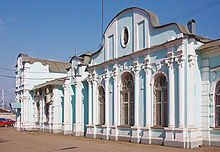Sofrino
| Urban-type settlement
Sofrino
Sofia
|
||||||||||||||||||||||||||||||||||
|
||||||||||||||||||||||||||||||||||
|
||||||||||||||||||||||||||||||||||
| List of large settlements in Russia | ||||||||||||||||||||||||||||||||||
Sofrino ( Russian Софрино ) is an urban-type settlement in Moscow Oblast , Russia . It belongs to the Rajon (district) Pushkino and has 15,771 inhabitants (as of October 14, 2010).
geography
The place is about 40 kilometers northeast of Moscow , 13 km north of the Rajon center Pushkino and 22 km southwest of the city Sergiev Posad .
The Trans-Siberian Railway runs through Sofrino on the section between Moscow and Yaroslavl with a regional train station also called Sofrino. To the north of this, a branch line branches off to Krasnoarmeisk , about 15 km away . In addition, the M8 trunk road (called "Jaroslawler Chaussee") and the A107 ring road intersect immediately southeast of Sofrino .
history
Sofrino was first mentioned in a document around 1632 and was originally called Safarino or Soforino , which presumably comes from the family name Safarin (Сафарин). From the 18th century the place was known as a noble residence and belonged alternately to several families close to the Tsar's court . Since Sofrino was on the busy road between Moscow and the Trinity Monastery of Sergiev Posad , which was already a place of pilgrimage at that time, it was visited several times by the tsars and their relatives.
After a railway branch to Krasnoarmeisk was built from Sofrino in the early 20th century , the village became a traffic junction and from the 1920s housing developments for railway workers were built around the station. In the second half of the century, new residential areas were built in Sofrino based on the model of cities, as well as the first industrial company. In 1958, Sofrino received urban-type settlement status.
Population development
| year | Residents |
|---|---|
| 1959 | 6,729 |
| 1970 | 8,717 |
| 1979 | 8,407 |
| 1989 | 11,866 |
| 2002 | 15,481 |
| 2010 | 15,771 |
Note: census data
economy
The most famous company in Sofrino today is the "Sofrino Art and Manufacturing Company", which belongs to the Moscow Patriarchate of the Russian Orthodox Church . In his workshops icons, candles, candlesticks and other church utensils, but also printed material such as Orthodox church calendars, are made. Because of this production, the place name Sofrino is known nationwide in Russia.
Personalities
- Vladimir Fyodorowitsch Borissow (1961-2010), mathematician
Attractions
The historical buildings of Sofrino include the Smolensk Church from 1691 and the station building, which was designed by the well-known architect Alexei Shtusev . In addition, a few kilometers north of Sofrino, near the Ashukinskaya railway station , the Muranovo Museum is located . This is a former estate with a mansion built in 1842, in which the poet Yevgeny Baratynski and later the poet Fyodor Tyuttschew lived.
Individual evidence
- ↑ a b Itogi Vserossijskoj perepisi naselenija 2010 goda. Tom 1. Čislennostʹ i razmeščenie naselenija (Results of the All-Russian Census 2010. Volume 1. Number and distribution of the population). Tables 5 , pp. 12-209; 11 , pp. 312–979 (download from the website of the Federal Service for State Statistics of the Russian Federation)
Web links
- Sofrino's unofficial website (Russian)
- Official website of the church company Sofrino (Russian)



